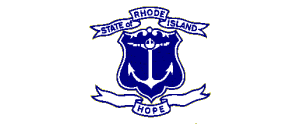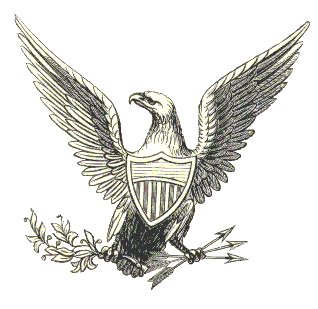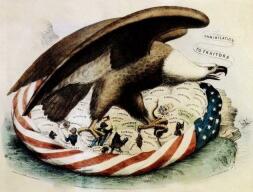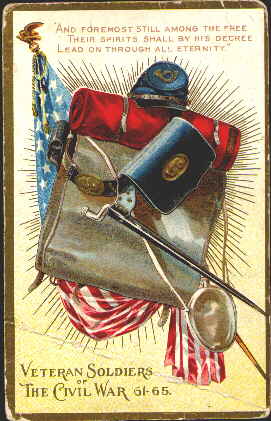


 |
 |
 |

 A BRIEF HISTORY OF THE 2nd REGIMENT, RHODE ISLAND VOLUNTEER INFANTRY, R.I.D.M. After the firing on Fort Sumter by South Carolina on April 12-13, 1861, and the fort's surrender on the 14th, and President Lincoln's first call to arms for 90 day volunteers that same week, by May it became apparent to the War Department that longer serving Federal forces might be needed to deal with the crisis of seceding Southern States. The growing situation might be greater than the first call out of 90 day troops by the President could handle. Upon President Lincoln’s second call for 3 year enlistments in mid May 1861, Governor William Sprague issued a Rhode Island order on May 30 to form the first regiment, in compliance to the President’s 3 year enlistment request. On June 6, 1861, Major John Slocum, serving in Colonel Ambrose E. Burnside's 1st R.I. Detached Militia Infantry Regiment, already deployed in Washington, was summoned to return to Rhode Island by Governor Sprague. Upon his return Sprague promoted Slocum to the rank of Colonel with orders to form and command the 2nd R.I. Volunteer Infantry Regiment, the State’s first 3 year unit. Slocum begin organizing his new regiment at Camp Burnside on the Dexter Parade & Fair Grounds, located on the corner of Dexter and Cranston Streets in Providence, (which today is the site of a R.I. Army National Guard Armory, built in 1900, by Elisha Dyer, Jr). Since the War Department was pushing for a quick end to the crisis with the Southern States, General McDowell, in over-all command of Union forces in and around Washington D.C., was urged (against his better judgment) to invade Virginia and crush the rebellion at his earliest convenience. McDowell expressed to President Lincoln that he felt an invation at that time was ill-advised because his troops were far too green to engage the Rebels in a major battle and asked for more time to train his army. Lincoln's answer was "They are green too---you are all green alike". Therefore the 2nd Rhode Island was rushed from its training camp to the field and left Rhode Island for Washington, D.C., on June 19, 1861. Upon its arrival in Washington the 2nd R.I. Infantry was attached to Burnside's Brigade, Hunter's Division, McDowell's Union Army of Northeast Virginia. The 2nd would be a part of the Rhode Island Brigade until August. On July 21, 1861, Burnside’s Brigade led the advancing Union forces in to battle at Bull Run, across the Potomac River in northern Virginia. The 2nd R.I. led the R.I. Brigade (the Union Army's lead element) on the march in to Virginia and was the first unit engaged, opening the first big battle of the Civil War. At the hight of the 1st Battle of Bull Run, Burnside’s Brigade nearly broke the rebel line, but the arrival of Rebel reinforcements under General Joe Johnston prevented a Union victory at a critical moment that would determine the outcome of the battle. Slocum and several of his officers were killed, but the 2nd fought well. Click to the Cartes De Visite Page of the 1st R.I. Infantry for more information about Slocum and his officers, including Sullivan Ballou. As the Union victory slipped away McDowell was powerless to change the final outcome and the Confederates routed most of his ill-trained army. In the end the 2nd R.I. stayed engaged and was one of the last units off the field even when it was evident the battle was lost. After the 1st Battle of Bull Run, the defeated Union Army retreated back to their encampments around Washington D.C. In August, the 2nd was reassigned to Couch's Brigade, Division of the Potomac, until October, 1861. Then the Division was reformed and the 2nd was put under General Darius Couch's Brigade, of Buell's Division, of George B. McClellan’s newly formed Grand Union Army of the Potomac. The 2nd R.I. stayed under Couch until March, 1862, when it was transferred to the 1st Brigade, 1st Division, 4th Army Corps, Army of the Potomac, to September, 1862. It fought in the 4th Corps under McClellan in the Peninsula Campaign in June and the Antietam Campaign in September. In October, 1862 the 2nd was assigned to General Frank Wheaton’s 1st Brigade, 1st Division, General William B. Franklin’s 6th Army Corps, Major General Burnside's Grand Army of the Potomac. It served in the 6th Corps to the end of the war. Wheaton, a professional soldier and a Rhode Islander, had taken command of the 2nd for a short time after the death of Slocum at 1st Bull Run. He was well respected by all his soldiers. All the men of the 2nd were glad they were under a Brigade Commander who was one of them and knew they would be treated well. In early 1863, under General Hooker's re-organization of the Union Army of the Potomac, the 2nd R.I. Volunteers were transferred to 2nd Brigade, under Frank Wheaton’s 3rd Division, 6th Army Corps, re-appointed under General John Sedgwick until March, 1864. The 2nd R.I. Volunteers fought in the 6th Corps under Wheaton, from Fredericksburg 1862, to Cold Harbor, 1864. See the Battle Service Record of the 2nd R.I. below. After the horrific Battle of Cold Harbor in June 1864, the enlistments ran out for about 1/3 of the men who were still left in the 2nd Regiment. Colonel Read, the regiment's 5th field commander, led the men of the 2nd to be mustered out back to Rhode Island. All those who had reenlisted to the end of the war in the 2nd R.I. were then commanded by the young Colonel Elisha Hunt Rhodes, the units 6th and last field commander during the Civil War. As Lt. General Ulysses Grant and his Union forces began to lay siege to Petersburg, the 6th Corps under General Philip A. Sheridan was sent from southern Virginia to northern Virginia to stop Rebel General Jubal Early from menacing Washington in raids out of the Shenandoah Valley. Grant appointed Sheridan commander of the 6th Corpes after its beloved Corps Commander, General John Sedgwick had been killed by a Rebel sharpshooter in the Battle of the Wilderness. As Sheridan took the 6th Corpes north from Petersburg, in operations to defend Washington the 2nd was assigned to the 4th Brigade, 2nd Division, 6th Army Corps, to July, 1864. After Washington was secured Sheridan looked west across the Potomac River to begin operations that would forever eliminate the Rebel threat to the nation's capitol by destroying the South's ability to wage war in northern Virginia. In Sheridan’s invasion of the Shenandoah Valley the 2nd R.I. Volunteers were assigned to the 3rd Brigade, 1st Division, 6th Army Corps, Army of the Potomac or Army of the Shenandoah, Middle Military Division, garrisoned at Winchester during the Battles of Cedar Creek and Fisher’s Hill that destroyed Early’s Rebel forces once and for all and knocked the valley out of the war as an vital supply resource for Lee and his Rebel Army defending Petersburg against Grant's main Union Army in southern Virginia. Fresh from their victories in the Shenandoah Valley, upon their return to Petersburg in December 1864, the 2nd Rhode Island was put back under Frank Wheaton’s 3rd Brigade, 1st Division, 6th Army Corps, Army of the Potomac, to July, 1865 and the end of the war. The 2nd Rhode Island participated in the operations to turn Lee's last flank defending Petersburg, the occupation of Petersburg and the battles and pursuit of Lee's Army to Appomattox; as well as Lee's surrender on April 9, 1865, which ended the war in Virginia. After Lee's surrender the 2nd was deployed in Danville along the Virginia-North Carolina border until Rebel General Joe Johnston's surrender to Union General Sherman. By summer the 2nd R.I. participated in the Grand review in Washington D.C and was mustered out to a great celebration in Providence, Rhode Island. See the Farewell address by Col. Elisha Hunt Rhodes to his men of the 2nd Rhode Island Volunteer Infantry in Providence on our Cartes De Visite Home Page # 1. Throughout its gallant service 1861 to 1865, the 2nd Rhode Island Volunteer Infantry was commanded by Colonels; John Slocum, Frank Wheaton, Nelson Viall, Horatio Rogers, Samuel Read and Elisha Hunt Rhodes. WAR SERVICE RECORD OF THE 2nd R.I. VOLUNTEERS ~1861~ Attached to Union Forces and first deployed at Camp Sprague, Washington, D.C., Md., until July 16, 1861. Advance on Manassas, Va., July 16-21. Battle of Bull Run under McDowell, Va., July 21. At Camp Sprague and Brightwood, Defenses of Washington, Md., until March, 1862. ~1862~ March to Prospect Hill, Va., March 11-15. Embarked at Alexandria, Va., to participate in McClellan’s Peninsula Campaign, Va., March 26. The Siege of Yorktown, Va., April 5-May 4. The Battle of Williamsburg, Va., May 5. The Battles of Slatersville & New Kent C.H., Va., May 9. Battle of Fair Oaks, and Seven Pines under MacClellan, Va., May 31-June 1. The Seven Days Battles before Richmond, Va., June 25-July 1. The Battle of Oak Grove near Seven Pines, Va., June 25. The Battle of James River Road near Fair Oaks, Va., June 29. Battle of White Oak Swamp, Va., June 30. Battle of Malvern Hill under MacClellan, Va., July 1. Deployed at Harrison's Landing, Va. until August 15. Reconnaissance to Turkey Island, Va., August 5-6, and to Haxall's Landing, Va., August 8-11. The movement of the Army of the Potomac to Alexandria, Va., August 15-September 1, to releive Washington after the 2nd Battle of Bull Run and distruction of Pope's Union Army. The march into Maryland and MacClellan's pursuit of Lee, September 3-18. The Battle of Antietam under MacClellan, Md., September 17. Deployment at Downsville, Maryland September 23-October 20. Movement to Stafford C. H. under Burnside, Va., October 20-November 18, and to Belle Plains, Va., December 5. Battle of Fredericksburg under Burnside, Va., December 12-15. ~1863~ The retreat from Fredericksburg to Falmouth, & “The Mud March” under Burnside along the Rappahannock River, Va., January 20-24. The Battle of Chancellorsville & Campaign under Hooker, Va., April 27-May 6. Operations at Franklin's Crossing, Va., April 29-May 2. The Battle of Marye’s Heights, & 2nd Battle of Fredericksburg under Sedgwick, Va., May 3. The Battle of Salem Heights, Va., May 3-4. The Battle of Banks' Ford, Va., May 4. The Battle of Deep Run Ravine or Franklin's Crossing, Va., June 5-13. The march to Pennsylvania and the Battle of Gettysburg under Meade, Pa., July 2-4. Deployment at Funkstown, Md., July 10-13, then at Warrenton, Va., until September. The Battle of Bristoe Campaign October 9-22. The advance to line along the Rappahannock River, Va., November 7-8. The Battle of Rappahannock Station, Va., November 7. Meade's Mine Run Campaign & Battle, Va., November 26-December 2. The retreat and re-deployment at Brandy Station, Va. until May, 1864. ~1864~ Grant's Rapidan Campaign, Va., May-June. The Battles of the Wilderness, Va., May 5-7; Spottsylvania, Va., May 8-12; Spottsylvania C. H., Va., May 12-21. Grant's Assault on the Salient, Va., May 12. The Battle of North Anna River, Va., May 23-26. On line of the Pamunkey River, Va., May 26-28. Battle of the Totopotomoy River, Va., May 28-31. The Battle of Cold Harbor, Va., June 1-12. The orginal 3 year enlistmented men of the 2nd R.I. left front to muster out June 11 and mustered out in Providence, R.I., June 17. The March to City Point and entrenched before Petersburg, Va., June 17-18. The Battle of Jerusalem Plank Road, Va., June 22-23. Siege of Petersburg, Va., until July 9. The moved to Washington, D.C., July 9-11. Repulse of Early's attack on Washington, Md., July 11-12. Sheridan's Shenandoah Valley Campaign, Va., August to December. Battle of Opequan, Winchester, Va., September 19. Garrison duty at Winchester, Va., September 22-December 1. The move back to Petersburg to re-join Grant, Va., December 2-6. Return to the Siege of Petersburg, Va., December, 1864, to April, 1865. ~1865~ The Battles of Dabney's Mills, Hatcher's Run, Va., February 5-7. The Battle of Fort Fisher, Petersburg Line, Va., March 25. Grant's Appomattox Campaign and pursuit of Lee, Va., March 28-April 9. Assault on and fall of Petersburg, Va., April 2. Pursuit of Lee April 3-9 and the Battle of Saylor’s Creek, Va., April 6. Lee’s Surrender at Appomattox, Va., April 9. The Expedition to Danville, Virginia along the North Carolina-Virginia border, April 23-27. The move to Washington, D.C. via Richmond, Va., May 20-June 7. The 6th Corps, Army of the Potomac participation in the Grand Review, for President Andrew Johnson and the Nation, up Pennsylvania Avenue, Washington D.C, June 8. Mustered out of United States Service in Providence, R.I., July 13, 1865. See the Farewell address by Col. Elisha Hunt Rhodes to his men of the 2nd Rhode Island Volunteer Infantry in Providence on our Cartes De Visite Home Page # 1.
~2nd Infantry Regiment Of Rhode Islanders Lost During The Great War Of The Rebellion of Southern States, 1861-1866~
During its service in the Civil War, the 2nd Rhode Island Volunteer Infantry Regiment lost 9 Officers killed in direct combat and 2 Officers died mortally wounded, 111 Enlisted men were killed or mortally wounded and 74 Enlisted men died by disease. Their total losses were 196 men throughout the war and they participated in every major campaign and battle in Virginia, Maryland and Pennsylvania from 1861 to 1865 with the Union Army of the Potomac. |






